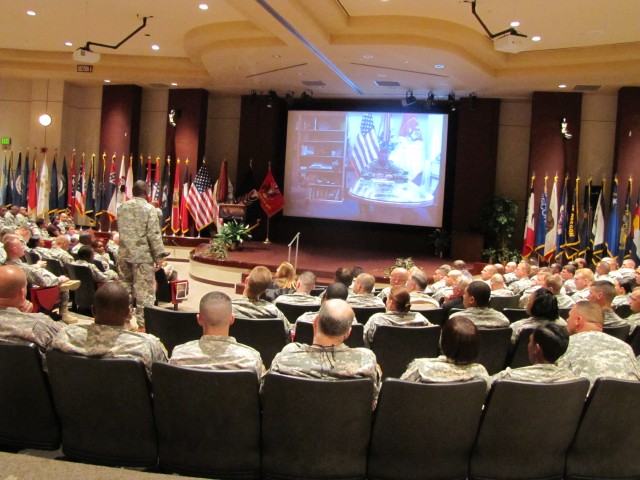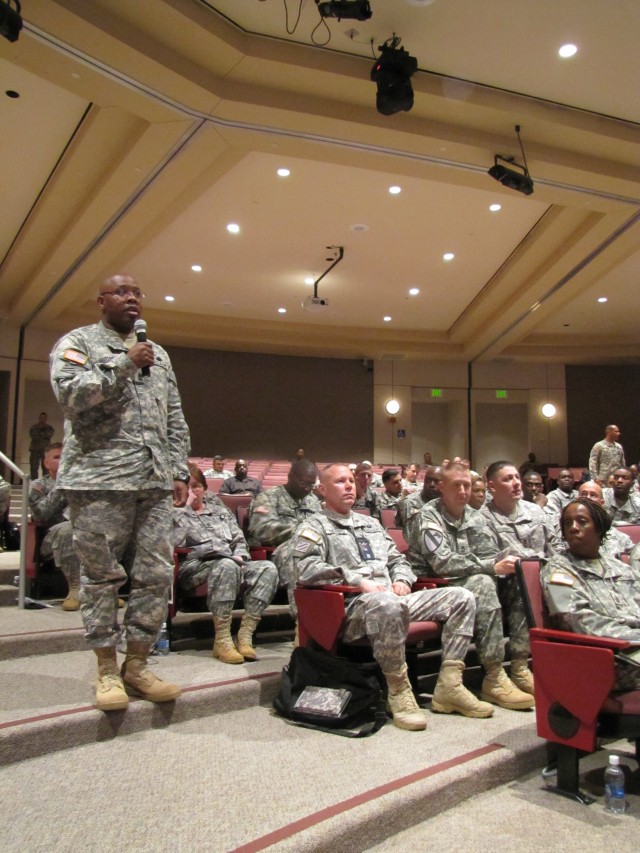REDSTONE ARSENAL, Ala. -- The enlisted Soldier can be found pretty much anywhere in the world, representing a nation that is committed to protecting freedom and democracy.
The demands on that Soldier are tremendous in an era of persistent conflict "that will continue for years and probably for decades to come," Sgt. Maj. of the Army Kenneth Preston said.
The highest ranking enlisted Soldier spoke via video teleconference to Soldiers attending the annual Worldwide Logistics Training Workshop on April 27. The meeting, hosted by AMC's Logistics Support Activity, was held in Bob Jones Auditorium.
Emphasizing the need for leadership within all ranks of the Army, Preston gave his audience a view of Soldiers worldwide. Eighty-six percent of the Army is made up of enlisted Soldiers. The Army has a total of 558,840 active Soldiers, 207,750 Reserve Soldiers and 362,000 National Guard Soldiers, for a total Army of 1.128 million Soldiers.
The Army's global commitment includes 257,860 Soldiers deployed in nearly 80 countries in the world. Of its deployed Soldiers, 83,040 are serving in Iraq, 51,840 in Afghanistan and 11,570 in Kuwait.
Today's era of persistent conflict is caused, Preston said, by several factors, including globalization, resource competition, proliferation of weapons of mass destruction, climate change, failed and failing states, and demographic trends.
"The global marketplace, especially with technology, brings wealth and prosperity to many people living sheltered and impoverished lives, and who use technology to achieve their own desires and outcomes ... Resource competition creates strife and competition ... Weapons of mass destruction become more dangerous in a world where we have 1,200 known terrorist groups today," he said.
"Failed and failing states are another huge concern because countries cannot or will not defend their borders and protect their citizens against terrorists coming in and out of their borders ... Climate change and natural disasters will potentially require more boots on the ground."
The four principle roles of the Army's land forces are to prevail, engage, support, and deter and defeat.
"We need to prevail in protracted contingency capacities. We need to engage and help other nations build their capacity and grow their security forces to protect their own people. We need to support civil authorities. And we need to deter and defeat hybrid threats and hostile state actors. I really see us as an Army being responsible to take on full spectrum operations."
The U.S. is now in its ninth year in the Global War on Terror, and Preston said current demands outweigh readiness and strategic flexibility, and threaten the ability to sustain an all-volunteer force.
With frequent deployments, active duty Soldiers are leaving the service, saying "I really love the Army, but I need time at home" and National Guard and Reserve Soldiers are finding it more difficult to balance their military career with their civilian career and are being forced "to make tough choices," Preston said.
It is imperative that the Army restore balance by sustaining, preparing, resetting and transforming its organizations.
"We need to recruit the highest quality Soldiers, and retain the very best Soldiers and leaders. We've done very well the last six years, and that can be attributed to your leadership and the environment you create," Preston told his audience, which was primarily NCOs.
"We need Soldiers who want to re-enlist, who want to continue to be part of the team, who want to be in that band of brothers and sisters."
Those Soldiers need to be trained and prepared to lead in conflict and be equipped with the best equipment possible, something that is difficult to sustain in the current uptempo environment.
"With the pace and tempo we are at, we consume our equipment very quickly," he said. "Our systems get five to six years worth of wear and tear for every year they are in theater. At some point, the equipment has got to come out, and be rebuilt and refurbished."
The Army's rebalancing involves the use of modular formations, where units consist of 3,000-to-4,000-Soldier brigade combat teams that are organized closer to the way Soldiers fight. The Army is 85 to 90 percent complete with this transformation.
"In the last three or four years, we've grown the Army very, very quickly," he said. Preston also touched on the five dimensions of Soldier strength - physical, emotional, social, family and spiritual - and on the comprehensive Soldier fitness program.
"We must prepare ourselves for the rigors and physical demands of combat ... We have found that Soldiers actually grow from the experience of deployment. A high percentage of Soldiers deployed to a hostile environment come back from that deployment stronger and happier than when they left," he said.
"They've been challenged. They survived that and when they came back from the deployment they've had a growth experience that can help them face any adversity. We want to build strength and resiliency for all our Soldiers throughout their military career."




Social Sharing